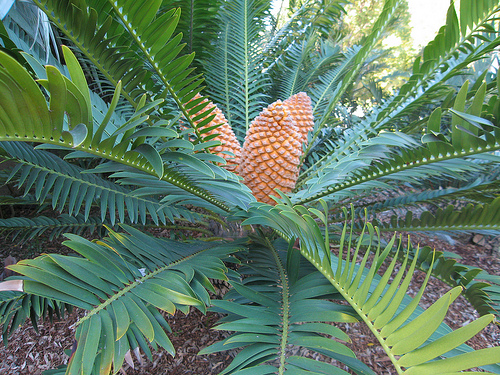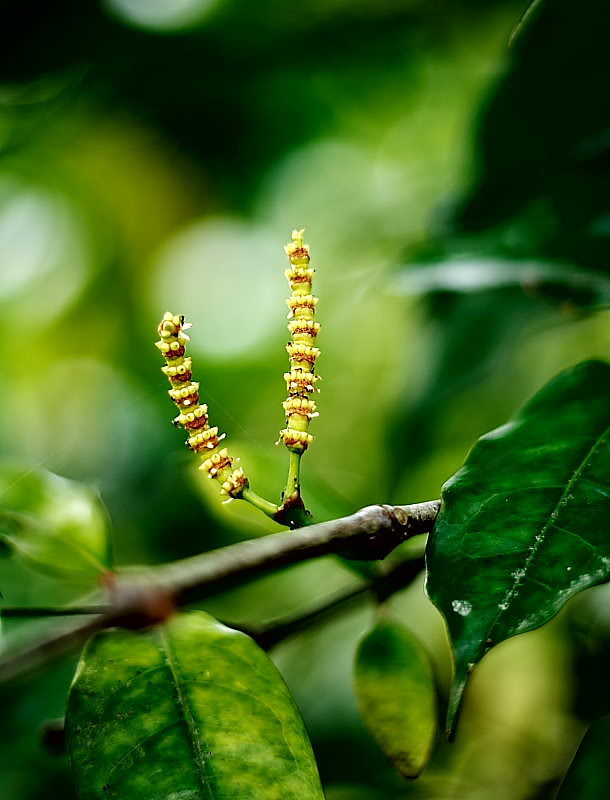Gymnosperms are seed-bearing vascular plants, such as cycads, ginkgo, yews and conifers, in which the ovules or seeds are not enclosed in an ovary. The word "gymnosperm" comes from the Greek word gymnospermos, meaning "naked seeds". Gymnosperm seeds develop either on the surface of scale or leaf-like appendages of cones, or at the end of short stalks.
The largest group of living gymnosperms are the conifers (pines, cypresses and relatives) and the smallest is ginkgo, a single living plant species found in China.
There are considerably fewer gymnosperms than there are angiosperms. Most classifications of gymnosperms include about 65 genera and 720 species. For centuries they were lumped into a single class of seed plants, but botanists now consider them sufficiently diverse to be separated into four extant divisions: Ginkgophyta (maidenhair tree), Cycadophyta (cycads), Pinophyta (conifers), and Gnetophyta (gnetophytes).

Ginkgo, the maidenhair tree, derive its Latin name from two Chinese words meaning “silver apricot.” Ginkgo biloba, which has remained virtually unchanged for 80 million years, is the only living representative of the division. Its distinctive, fan-shaped leaves with dichotomous venation are produced on two types of shoots: relatively fast growing long shoots and seedlings produce leaves with a distinct apical notch (hence, biloba), while slow-growing spur shoots produce leaves without a notch.
Ginkgo trees are deciduous, a feature that otherwise occurs only in a few members of the Pinophyta. Ginkgo is a popular cultivated tree, but it is appropriately extinct in nature. All living Ginkgo trees are descendants of plants that were grown in temple gardens of China and Japan.

There are about 10 genera and 100 species of cycads, distributed primarily in the tropical and subtropical regions of the world. All species of cycads are dioecious.
Cycads have palmlike leaves that bear no resemblance to the leaves of other living gymnosperms. Under favorable conditions, cycads usually produce one crown of leaves each year. In some cycads, the roots grow at the surface of the soil and develop nodules containing nitrogen-fixing cyanobacteria.
Cycads have simple, often shield-shaped or bractlike sporophylls that may be covered with thick hairs, which is usually occur in large strobili. The seeds of cycads are more likely those of Ginkgo than those any other gymnosperm; they have a three-layered integument, but the inner layer is soft instead of papery.

The informal name of this group, conifers, signifies plants that bear cones, even though other divisions of gymnosperms also include cone-bearing species. Members of the genus Pinus, considered typical for the Pinophyta, are the most abundant trees in the Northern Hemisphere; many of the species in conifer forests are pines. They have also been widely planted in parts of the Southern Hemisphere, but only the Merkus pine, whose distribution barely extends south of the equator in Sumatra, is native south of the equator.
Like Ginkgo, pines have short shoots, long shoots, and two kinds of leaves. The more obvious type of leaf is the pine needle, which occurs in groups, called fascicles, of generally two to five needles. A few species have as many as eight needles per fascicle, and others have only one.

The gnetophytes include some of the most distinctive of all seed plants. There are three clearly defined genera, each in its own order, and seventy-one woody species. These genera are Ephedra (forty species), Gnetum (thirty species), and Welwitschia (one species).
Gnetophytes are unique among gymnosperms because after one of the sperm cells from a male gametophyte fertilizes an egg, the second sperm cell fuses with another cell in the same female gametophyte. Thus, gnetophytes undergo double fertilization, a process otherwise known only in the angiosperms.